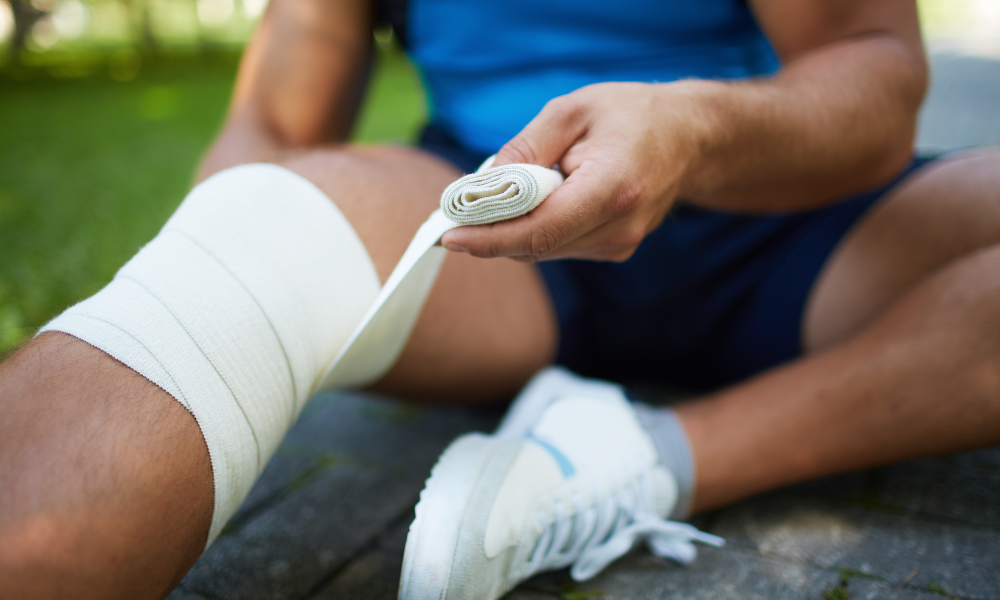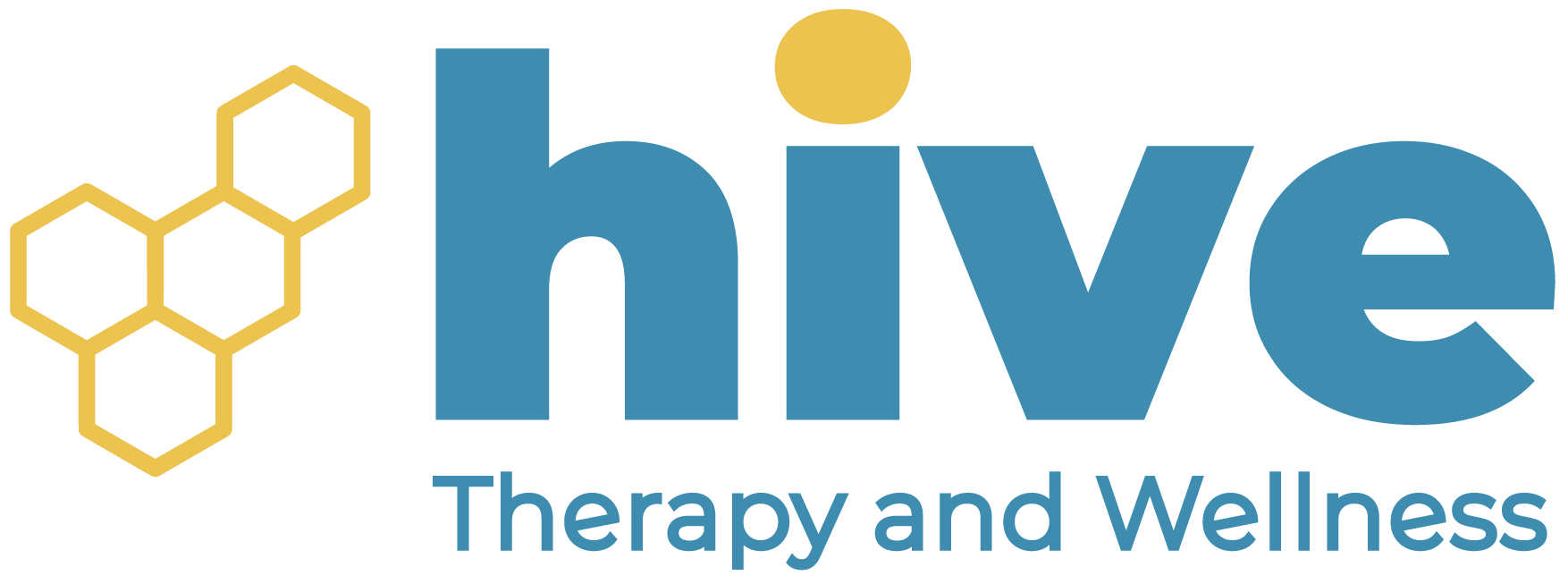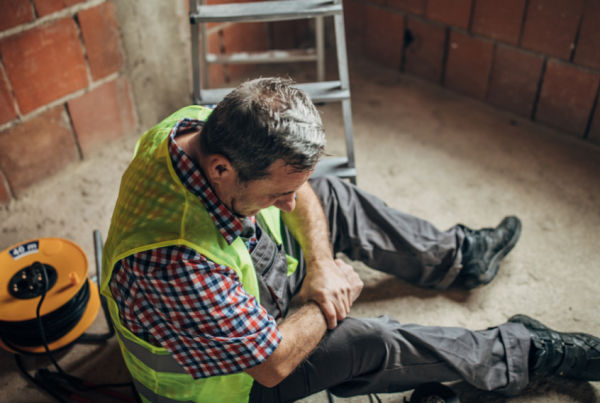Sprains and Strains
Move Better. Live Fuller. Your Wellness Journey Starts Here.
Schedule a FREE Discovery Call!
About Sprains and Strains
Sprains and strains are common soft tissue injuries that can cause pain, swelling, bruising, tenderness, and limited mobility. These injuries involve the tearing or stretching of an inner bodily structure: A sprain is an injury of a ligament, whereas a strain is an injury to a muscle or tendon.
Both sprains and strains can be graded by their severity from Grade 1 (no significant tissue tearing) to Grade III (a complete tearing of a tissue). Although these two injuries may sound similar, each affects a different structure of the body and therefore will occur in different locations. Additionally, the symptoms of strains and sprains are similar, but can vary slightly.
Let’s take a look at each type of injury in more detail:

Sprains
As briefly mentioned before, a sprain affects your ligaments, which are fibrous bands of strong tissue that connect your bones together at a joint. Ligaments can be stretched or torn due to poor form, overextension, sudden impact, or unnatural movement. Sprains usually affect areas such as the ankles, knees, shoulders, and wrists. The grading for sprains can be described as follows:
- Grade I: A mild injury involving a slight stretching of the ligament and possibly some light damage to the ligament’s fibers. This type of injury doesn’t affect function or stability, but may create discomfort or stiffness.
- Grade II: A more moderate injury that causes partial tearing of the ligament. These types of injuries can make a joint feel loose. It may be moderately painful and can make movement uncomfortable or difficult.
- Grade III: The most severe type of sprain that involves complete tearing of the ligament. This injury creates instability and dysfunction in the joint. This type of sprain can be very painful, and may prevent you from performing normal movements.
Strains
A strain is an injury to a muscle or tendon, which attaches muscle to bone. This type of injury occurs when either a muscle or tendon is torn or overstretched. A strain can be caused by overexertion or sudden movements, and is sometimes called a “pulled muscle.” It commonly happens when you use a muscle that wasn’t properly prepared for a strenuous task. Strains can occur in the neck, back, hamstrings, calves, biceps, triceps, and more.
When grading strains, the symptoms are as follows:
- Grade I: Refers to slight stretching or damage of muscles or tendons, which may cause discomfort but doesn’t affect strength or function.
- Grade II: Moderate damage or tearing of the muscles or tendons. When the fibers of these structures are partially torn, it can create weakness and significant pain.
- Grade III: Severe damage that causes a complete loss of function and extreme pain.
Both sprains and strains can be considered acute or chronic. Acute injuries are sudden and usually caused by a single action or impact. Chronic injuries are those that develop over time from repeated movements or overuse.
Sprains and strains are often acute injuries, but when an injury doesn’t heal properly or occurs repeatedly to the same area of the body, an individual may experience chronic symptoms. This can create symptoms of long-term instability and weakness.
What Causes Sprains or Strains?
Sprains and strains may seem like similar injuries, but they are caused by different factors. Sprains, which involve ligaments, are typically caused by sudden impact or movements that move a joint beyond its normal range of motion. This can include falls, twisting, or physical impact. While these can happen to anyone, they are very common in athletes—especially those who play impact sports.
Strains are injuries that involve the overuse or overstretching of a muscle or tendon. When you improperly lift an object or fail to condition your body before doing strenuous activity, you increase your risk of strain. Other things like performing repetitive movements or moving with poor posture can gradually create strains.
Although they are caused by slightly different factors, both sprains and strains can be better prevented by practicing good posture, keeping proper form during exercise, warming up your body before activities, and taking preventative measures for your environment. Next, we’ll discuss the role that physical therapy plays in treatment and prevention of these injuries.
Physical Therapy for Sprains and Strains
Luckily, sprains and strains don’t usually require surgery. For many, rest and physical therapy can be sufficient for healing. Initially, these types of injuries require “RICE,” or rest, ice, compression, and elevation. This is an immediate measure to reduce swelling and further injury. Additionally, you can often begin physical therapy just a few days after a sprain or strain, depending on your individual case and the severity of the injury.
Although these injuries don’t usually require surgery, that doesn’t mean you shouldn’t give your body the care and attention it deserves. Physical therapy is incredibly beneficial even for these soft tissue injuries, as it can address pain and swelling, restore function, and prevent future injury. Working with a professional is the most efficient way to restore function, movement, and flexibility to your body! Engaging in physical therapy is the best way to prevent long-term complications, especially with more severe sprains or strains.
Physical therapists can use a variety of treatments to manage your pain, stabilize the injured area, restore your strength and flexibility, and even lower your risk of future injury. Let’s look at a few examples:
Pain Management
Depending on the severity and type of injury you experience, your pain can be anything from mild discomfort to significant pain and dysfunction. The providers Hive Therapy and Wellness offer a wide variety of pain-relieving treatments that are suitable for sprains and strains. Many of these pain relieving treatments offer added benefits of improved muscle function, strengthening or relaxation, and enhanced recovery!
Some examples can include temperature therapy, electrical muscle stimulation, dry needling, tissue scraping, manual therapies, and more. Rest assured that your physical therapist will always take your current stage of recovery into consideration, and will only perform treatments that are suitable for your current needs.
Exercises and Stretching
A major part of restoring strength, function, and movement to your body after a sprain or strain is with gradual activity and stretching. Your physical therapist can lead you through safe exercises that will stabilize and strengthen the injured area, as well as become progressively more difficult as your healing improves.
Working with a physical therapist can be very advantageous when it comes to stretching and exercise, as it is possible to overload your tissues or even underwork them during healing. This means that you risk re-injuring your body, or healing without restoring the full range of motion and function of your body.
Education
Physical therapists can provide a wealth of useful information and education that you may not have considered! They can teach you the proper use of braces, splints, or other supportive healing tools as well as educate you on a variety of topics to prevent future injury. This can include:
- How to warm up your body before sports, exercise, or strenuous activity.
- The proper posture for lifting, bending over, and other common movements.
- Exercises and stretches to maintain good physical health.
- Strategies or modifications to your sports or other activities to reduce your risk of re-injury.
- Suggestions in terms of environmental changes or equipment that will reduce the risk of accidents and future injury.
Sports Conditioning
The physical therapists at Hive Therapy and Wellness value preventative health for all. While each person’s treatment plan will always include strategies for preventing re-injury, some individuals are at higher risk of strains and sprains.
If you are someone who engages in sports, whether recreationally or professionally, it can be beneficial to work with a physical therapist for sports performance training. This curated training plan not only lessens your risk of injury, but can also help you perform better in your sport.
Even if you don’t engage in sports, physical therapy can get you back to doing what you love by improving your health and function after a sprain or strain. The physical therapists at Hive Therapy and Wellness are very experienced with a wide variety of injuries and patient needs. They are dedicated to providing a comprehensive and individualized treatment experience for each and every patient! This means that while receiving care at Hive, you may engage in any of the following treatment methods:
- Neuromuscular re-education
- Manual therapy
- Exercise prescription
- Dry needling
- Cupping
- Tissue scraping
- Behavioral modifications
- Therapeutic activities
- Electrical muscle stimulation
- Spinal manipulation
- Therapeutic modalities
- Biofeedback
Both sprains and strains can be graded by their severity from Grade 1 (no significant tissue tearing) to Grade III (a complete tearing of a tissue). Although these two injuries may sound similar, each affects a different structure of the body and therefore will occur in different locations.
Additionally, the symptoms of strains and sprains are similar, but can vary slightly. Let’s take a look at each type of injury in more detail:
Sprains
As briefly mentioned before, a sprain affects your ligaments, which are fibrous bands of strong tissue that connect your bones together at a joint. Ligaments can be stretched or torn due to poor form, overextension, sudden impact, or unnatural movement.
Sprains usually affect areas such as the ankles, knees, shoulders, and wrists. The grading for sprains can be described as follows:
- Grade I: A mild injury involving a slight stretching of the ligament and possibly some light damage to the ligament’s fibers. This type of injury doesn’t affect function or stability, but may create discomfort or stiffness.
- Grade II: A more moderate injury that causes partial tearing of the ligament. These types of injuries can make a joint feel loose. It may be moderately painful and can make movement uncomfortable or difficult.
- Grade III: The most severe type of sprain that involves complete tearing of the ligament. This injury creates instability and dysfunction in the joint. This type of sprain can be very painful, and may prevent you from performing normal movements.
Strains
A strain is an injury to a muscle or tendon, which attaches muscle to bone. This type of injury occurs when either a muscle or tendon is torn or overstretched. A strain can be caused by overexertion or sudden movements, and is sometimes called a “pulled muscle.”
It commonly happens when you use a muscle that wasn’t properly prepared for a strenuous task. Strains can occur in the neck, back, hamstrings, calves, biceps, triceps, and more.
When grading strains, the symptoms are as follows:
- Grade I: Refers to slight stretching or damage of muscles or tendons, which may cause discomfort but doesn’t affect strength or function.
- Grade II: Moderate damage or tearing of the muscles or tendons. When the fibers of these structures are partially torn, it can create weakness and significant pain.
- Grade III: Severe damage that causes a complete loss of function and extreme pain.
Both sprains and strains can be considered acute or chronic. Acute injuries are sudden and usually caused by a single action or impact. Chronic injuries are those that develop over time from repeated movements or overuse.
Sprains and strains are often acute injuries, but when an injury doesn’t heal properly or occurs repeatedly to the same area of the body, an individual may experience chronic symptoms. This can create symptoms of long-term instability and weakness.
Sprains and strains may seem like similar injuries, but they are caused by different factors. Sprains, which involve ligaments, are typically caused by sudden impact or movements that move a joint beyond its normal range of motion.
This can include falls, twisting, or physical impact. While these can happen to anyone, they are very common in athletes—especially those who play impact sports.
Strains are injuries that involve the overuse or overstretching of a muscle or tendon. When you improperly lift an object or fail to condition your body before doing strenuous activity, you increase your risk of strain.
Other things like performing repetitive movements or moving with poor posture can gradually create strains.
Although they are caused by slightly different factors, both sprains and strains can be better prevented by practicing good posture, keeping proper form during exercise, warming up your body before activities, and taking preventative measures for your environment.
Next, we’ll discuss the role that physical therapy plays in treatment and prevention of these injuries.
Luckily, sprains and strains don’t usually require surgery. For many, rest and physical therapy can be sufficient for healing. Initially, these types of injuries require “RICE,” or rest, ice, compression, and elevation.
This is an immediate measure to reduce swelling and further injury. Additionally, you can often begin physical therapy just a few days after a sprain or strain, depending on your individual case and the severity of the injury.
Although these injuries don’t usually require surgery, that doesn’t mean you shouldn’t give your body the care and attention it deserves. Physical therapy is incredibly beneficial even for these soft tissue injuries, as it can address pain and swelling, restore function, and prevent future injury.
Working with a professional is the most efficient way to restore function, movement, and flexibility to your body! Engaging in physical therapy is the best way to prevent long-term complications, especially with more severe sprains or strains.
Physical therapists can use a variety of treatments to manage your pain, stabilize the injured area, restore your strength and flexibility, and even lower your risk of future injury. Let’s look at a few examples:
Pain Management
Depending on the severity and type of injury you experience, your pain can be anything from mild discomfort to significant pain and dysfunction.
The providers Hive Therapy and Wellness offer a wide variety of pain-relieving treatments that are suitable for sprains and strains. Many of these pain relieving treatments offer added benefits of improved muscle function, strengthening or relaxation, and enhanced recovery!
Some examples can include temperature therapy, electrical muscle stimulation, dry needling, tissue scraping, manual therapies, and more. Rest assured that your physical therapist will always take your current stage of recovery into consideration, and will only perform treatments that are suitable for your current needs.
Exercises and Stretching
A major part of restoring strength, function, and movement to your body after a sprain or strain is with gradual activity and stretching. Your physical therapist can lead you through safe exercises that will stabilize and strengthen the injured area, as well as become progressively more difficult as your healing improves.
Working with a physical therapist can be very advantageous when it comes to stretching and exercise, as it is possible to overload your tissues or even underwork them during healing. This means that you risk re-injuring your body, or healing without restoring the full range of motion and function of your body.
Education
Physical therapists can provide a wealth of useful information and education that you may not have considered!
They can teach you the proper use of braces, splints, or other supportive healing tools as well as educate you on a variety of topics to prevent future injury. This can include:
- How to warm up your body before sports, exercise, or strenuous activity.
- The proper posture for lifting, bending over, and other common movements.
- Exercises and stretches to maintain good physical health.
- Strategies or modifications to your sports or other activities to reduce your risk of re-injury.
- Suggestions in terms of environmental changes or equipment that will reduce the risk of accidents and future injury.
Sports Conditioning
The physical therapists at Hive Therapy and Wellness value preventative health for all. While each person’s treatment plan will always include strategies for preventing re-injury, some individuals are at higher risk of strains and sprains.
If you are someone who engages in sports, whether recreationally or professionally, it can be beneficial to work with a physical therapist for sports performance training. This curated training plan not only lessens your risk of injury, but can also help you perform better in your sport.
Even if you don’t engage in sports, physical therapy can get you back to doing what you love by improving your health and function after a sprain or strain. The physical therapists at Hive Therapy and Wellness are very experienced with a wide variety of injuries and patient needs.
They are dedicated to providing a comprehensive and individualized treatment experience for each and every patient! This means that while receiving care at Hive, you may engage in any of the following treatment methods:
- Neuromuscular re-education
- Manual therapy
- Exercise prescription
- Dry needling
- Cupping
- Tissue scraping
- Behavioral modifications
- Therapeutic activities
- Electrical muscle stimulation
- Spinal manipulation
- Therapeutic modalities
- Biofeedback
You can learn more about these treatments on our Treatments Page.





